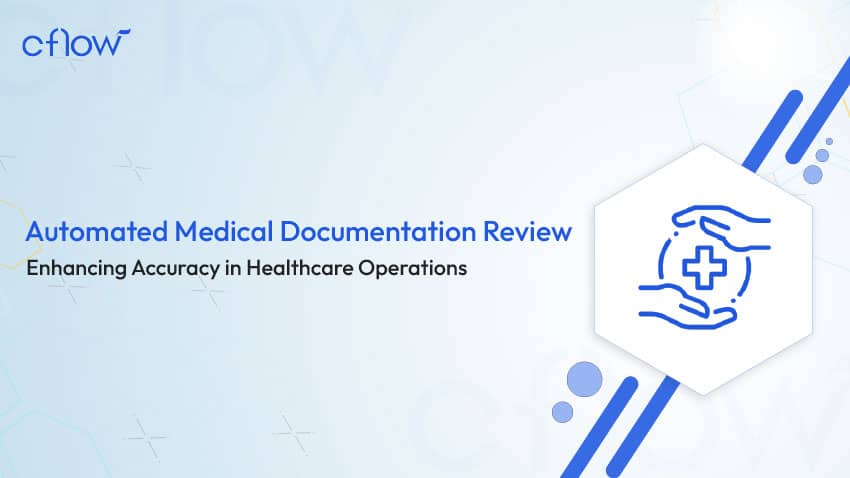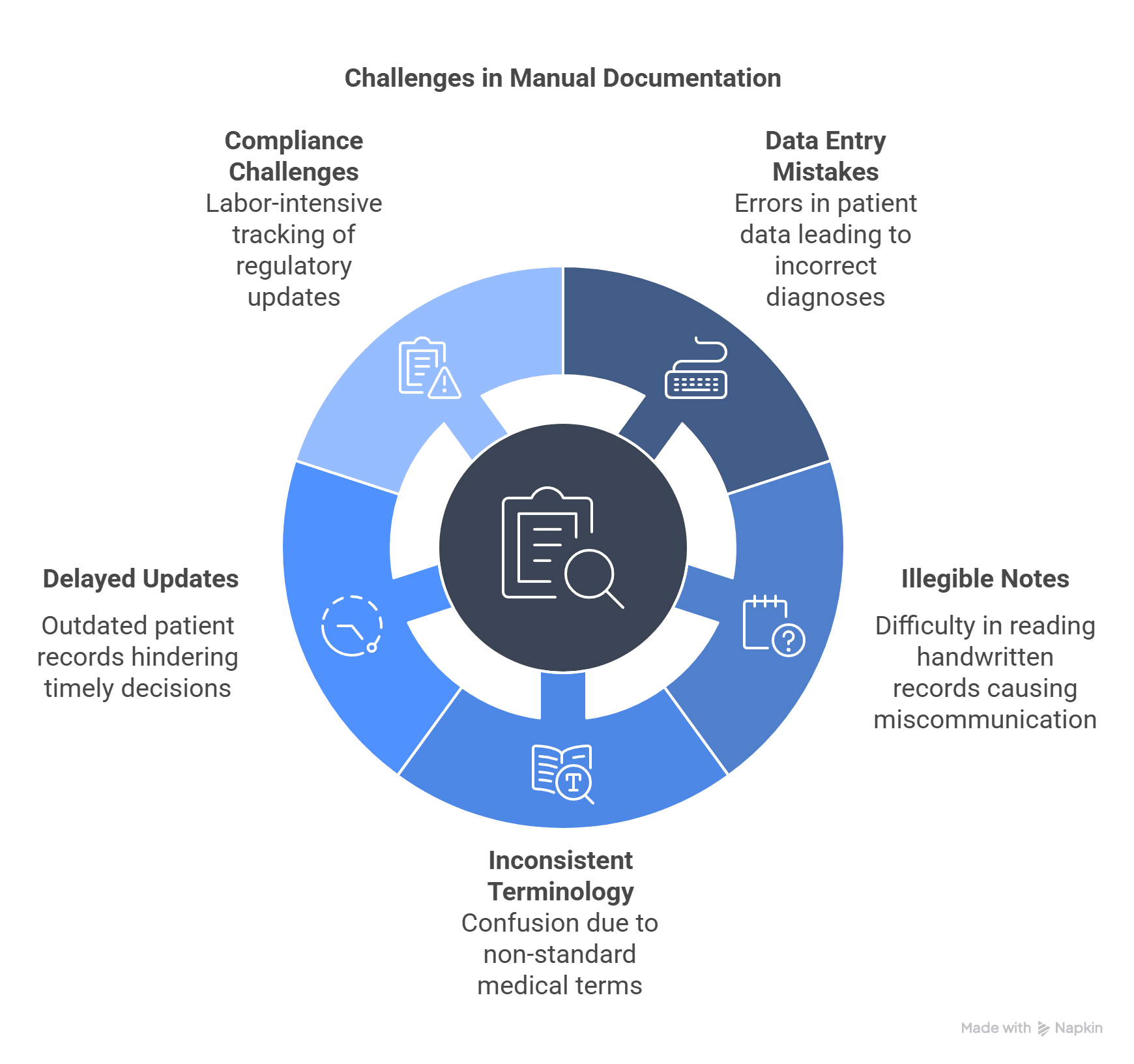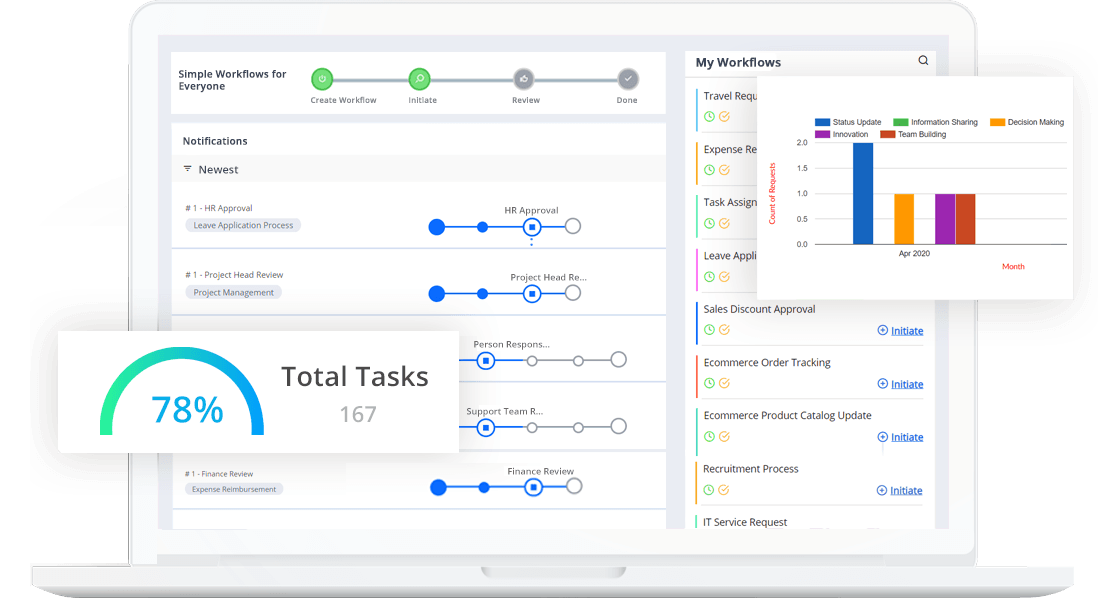Automated Medical Documentation Review – Enhancing Accuracy in Healthcare Operations

Key takeaways
- Automated medical documentation review enhances patient safety by eliminating transcription errors, misdiagnoses, and medication mistakes.
- AI-powered medical documentation review ensures compliance with HIPAA and other healthcare regulations, reducing legal risks and malpractice claims.
- Healthcare documentation automation minimises human errors, improves efficiency, and streamlines patient record management.
- Medical data accuracy with AI improves patient outcomes, reduces administrative burdens, and enhances interoperability between hospital systems.
Medical errors are among the leading causes of preventable harm in healthcare, with inaccurate documentation playing a significant role. Poor documentation leads to misdiagnoses, incorrect prescriptions, and treatment delays.
Traditional manual processes are often prone to inconsistencies, missing information, transcription mistakes, and the lack of proper communication, putting patient safety at risk. A study conducted by the Joint Commission found that 80% of serious medical errors were the result of miscommunication between caregivers during patient handovers.
AI-powered documentation automation is revolutionising healthcare by ensuring accuracy, compliance, and efficiency. In this blog, we’ll explore the common causes and consequences of medical documentation errors and how automated medical documentation review improves accuracy and compliance. We will also be looking into the steps to implement AI-driven documentation automation in healthcare settings and the future of medical data accuracy with AI.
Automated Medical Documentation Review
Automated medical documentation review leverages AI and machine learning to enhance the accuracy, consistency, and compliance of healthcare records. By automating data validation, transcription, and real-time error detection, this technology minimises manual errors that can lead to misdiagnoses, incorrect prescriptions, or compliance violations.
AI-powered medical documentation review ensures seamless integration with Electronic Health Records (EHRs), enabling instant updates and reducing administrative burdens for healthcare professionals. Additionally, it enhances regulatory compliance with HIPAA, GDPR, and other medical standards, ensuring audit-ready documentation. By implementing healthcare documentation automation, hospitals and clinics can improve patient safety, optimise workflow efficiency, and reduce operational risks.
The Impact of Medical Documentation Errors
Medical documentation plays a critical role in ensuring accurate diagnoses, appropriate treatments, and regulatory compliance. However, errors in patient records can have severe consequences, ranging from misdiagnoses and treatment delays to legal and financial risks.
A prominent article mentions, “Medical errors have been recognised as a serious public health problem, reported as the third leading cause of death in the U.S”. Hence, understanding the impact of these mistakes highlights the importance of automating documentation processes to reduce inaccuracies and enhance patient safety.
Understanding the Consequences of Inaccurate Records
Medical documentation errors affect patient care, hospital operations, and regulatory compliance, making them a major concern for healthcare providers. Below are some of the most critical risks associated with inaccurate records:
- Patient Safety Risks – Errors in patient histories, lab results, and prescriptions can lead to incorrect diagnoses, improper treatments, and even life-threatening complications.
- Medication Mistakes – Inaccurate or missing prescription details may result in overdoses, drug interactions, or failure to administer necessary medications, putting patients at severe risk.
- Legal & Compliance Issues – Failing to maintain accurate documentation exposes healthcare providers to malpractice lawsuits, penalties, and loss of accreditation under regulations like HIPAA and GDPR.
- Financial Losses – Hospitals suffer billing errors and insurance claim rejections due to documentation mistakes, impacting revenue streams and increasing administrative burdens.
Real-World Statistics on Medical Documentation Errors
The impact of documentation errors is reflected in several industry reports and studies:
- A study published in the Journal of Patient Safety found that more than 70% of errors resulting in adverse events were considered secondary to negligence, with over 90% judged as preventable.
- A report by Candello, analysing over 65,000 medical malpractice cases closed between 2014 and 2023, found that 20% of these cases involved at least one documentation failure.
- AI-powered tools have achieved an 85% automation rate in medical coding, streamlining billing processes and reducing errors that could lead to claim denials.
Why Traditional Medical Documentation Leads to Errors
Manual documentation in healthcare is prone to human error, inconsistencies, and inefficiencies that can lead to misdiagnoses, compliance violations, and patient safety risks. Despite advancements in electronic health records (EHRs), many healthcare providers still rely on manual data entry and handwritten documentation, creating opportunities for errors that impact patient outcomes and hospital efficiency. In a survey, 1 in 5 patients who read their medical notes reported finding a mistake, with 40% of these perceived errors considered serious.
Common Issues in Manual Documentation –
Traditional documentation processes introduce multiple challenges that compromise accuracy and efficiency in healthcare operations:

- Manual Data Entry Mistakes – Physicians and nurses manually inputting patient data often make typographical errors, omissions, or duplicate entries, which can lead to incorrect diagnoses and ineffective treatment plans.
- Illegible Handwritten Notes – Many providers still rely on handwritten records, making it difficult for healthcare teams to read, interpret, and act on crucial medical information, increasing the risk of miscommunication and medical errors.
- Inconsistent Terminology & Abbreviations – The use of non-standardised medical terms and abbreviations across different healthcare teams can confuse, leading to incorrect treatments or misinterpreted patient histories.
- Delayed or Missing Updates – Treatment modifications, lab results, and medication changes may not be updated in real-time, leading to outdated patient records that hinder timely medical decisions.
- Compliance & Regulatory Challenges – Healthcare providers must adhere to HIPAA, GDPR, and other regulations, but manual tracking of compliance updates is labour-intensive and highly prone to errors.
By automating medical documentation review, hospitals and clinics can eliminate these inefficiencies, improve record accuracy, and ensure compliance, ultimately enhancing patient safety and healthcare delivery.
How Automated Documentation Review Reduces Medical Errors
AI-powered documentation automation transforms healthcare workflows by enhancing data accuracy, reducing human errors, and streamlining compliance processes. Automated systems eliminate manual inefficiencies, ensuring that patient records are precise, up-to-date, and standardised across all departments.
Key Benefits of AI-Powered Documentation Automation –
Automating medical documentation processes provides numerous benefits that improve patient outcomes and reduce the risk of errors.
- AI-Powered Data Validation & Standardisation – AI-driven documentation systems structure medical records using standardised formats, reducing inconsistencies in diagnoses, prescriptions, and treatment histories.
- Automated Transcription & Speech Recognition – Physicians can dictate notes hands-free, allowing AI-powered systems to transcribe and structure clinical documentation accurately, reducing manual errors in patient records.
- Real-Time Error Detection & Alerts – AI-driven software identifies inconsistencies, missing information, and contradictions in patient histories, instantly flagging errors for review and correction.
- Smart Integration with EHR & Hospital Systems – Automated documentation seamlessly syncs patient records across departments, ensuring that lab results, imaging reports, and treatment plans are accessible.
- Enhanced Compliance Monitoring – AI-powered automation ensures that medical records comply with regulatory requirements, making it easy for healthcare providers to maintain audit-ready documentation effortlessly.
With AI-driven documentation automation, healthcare providers reduce medical errors, improve documentation accuracy, and enhance patient safety, ensuring efficient and compliant medical recordkeeping.
Key Medical Documentation Processes That Can Be Automated
Automation enhances efficiency in various medical documentation processes, from patient data entry to insurance billing and compliance tracking. By leveraging AI-powered automation, healthcare organisations eliminate redundant tasks, improve accuracy, and optimise patient record management.
Medical Documentation Tasks That Benefit from Automation –
Below are key areas where automation significantly reduces errors and enhances medical efficiency –
- Patient Data Entry & Medical History Updates – AI-powered systems extract and validate previous medical records, ensuring accurate and consistent patient histories without duplicate or missing information.
- Prescription & Medication Reconciliation – Automated medication tracking ensures real-time prescription updates, preventing incorrect dosages, adverse drug interactions, and duplicate prescriptions.
- Diagnostic & Lab Report Integration – AI-driven documentation solutions sync diagnostic test results, imaging reports, and lab findings with patient records, preventing missing or conflicting reports that may impact treatment decisions.
- Automated Coding & Billing Documentation – AI eliminates ICD-10 and CPT coding errors, ensuring accurate medical billing and preventing claim denials or financial discrepancies due to incorrect documentation.
- Medical Charting & Clinical Notes Automation – AI-powered systems help physicians and nurses structure, update, and retrieve patient notes quickly, significantly reducing documentation time and improving workflow efficiency.
Implementing Automated Documentation Review in Healthcare
As healthcare organisations shift toward digital transformation, implementing AI-powered documentation review ensures higher accuracy, compliance, and efficiency. By following a structured approach, hospitals and clinics can eliminate manual inefficiencies and reduce documentation-related medical errors.
Steps to Automate Medical Documentation –
Step 1 – Identify Documentation Challenges
Conduct a comprehensive audit to assess common documentation inefficiencies, errors, and compliance risks. Identify bottlenecks in data entry, patient history updates, and regulatory documentation.
Step 2 – Choose the Right Automation Technology
Select an AI-powered medical documentation solution that integrates with Electronic Health Record (EHR) systems, compliance platforms, and hospital workflows for seamless documentation management.
Step 3 – Train Healthcare Staff on AI-driven Tools
Provide structured, hands-on training sessions for doctors, nurses, and administrators to ensure effective use of AI transcription, compliance tracking, real-time error detection, and automated documentation review tools.
Step 4 – Ensure Compliance & Data Security
Implement HIPAA-compliant security measures, such as role-based access control, end-to-end encryption, automated audit trails, real-time data monitoring, and access restrictions to ensure maximum patient data privacy and regulatory compliance.
Step 5 – Monitor & Optimise AI-Powered Workflows
Continuously analyse system efficiency, measure accuracy improvements, track documentation performance, optimise AI-driven workflows, and refine automated models to enhance recordkeeping precision and prevent recurring documentation errors effectively.
End-to-end workflow automation
Build fully-customizable, no code process workflows in a jiffy.
The Future of AI-Driven Documentation Review in Healthcare
With the rapid adoption of AI and automation, the future of medical documentation review is set to become smarter, more secure, and highly efficient. Advanced technologies like Natural Language Processing (NLP), blockchain, and predictive analytics will play a significant role in transforming clinical documentation accuracy and data security.
Emerging Trends in Medical Documentation Automation –
- AI & Natural Language Processing (NLP) in Medical Transcriptions – AI-powered voice recognition tools will enable physicians to dictate clinical notes hands-free while ensuring documentation accuracy.
- Blockchain for Secure Medical Recordkeeping – Decentralised blockchain technology will enhance security, prevent unauthorised access, and ensure compliance with healthcare regulations.
- Predictive Analytics for Proactive Error Prevention – AI-driven predictive models will flag potential documentation errors before they occur, helping reduce medical mistakes.
- Automation-Driven Interoperability Between Healthcare Systems – AI-powered automation will enable real-time data exchange between hospitals, pharmacies, and insurers for seamless patient record synchronisation.
- AI-Powered Decision Support for Clinical Documentation – AI-driven documentation tools will assist healthcare professionals in structuring records accurately and ensuring compliance with medical best practices.
Medical Documentation with Cflow’s AI-Driven Automation
Cflow is a no-code workflow automation platform specifically designed to optimise medical documentation processes, eliminate errors, and enhance regulatory compliance. By leveraging AI-powered workflow automation, healthcare providers can reduce administrative burden, streamline patient data management, and improve accuracy in clinical documentation.
Cflow enables hospitals, clinics, and healthcare facilities to automate error detection, ensure compliance adherence, and maintain accurate patient records across departments.
Key Features of Cflow for Healthcare –
- AI-Powered Documentation Review – Cflow’s AI-driven automation detects inconsistencies, missing information, and regulatory violations in patient records. By flagging errors in real-time, healthcare providers can prevent medical inaccuracies and maintain high data integrity.
- EHR Integration & Real-Time Data Syncing – Seamlessly integrates with Electronic Health Records (EHRs) and hospital management systems, ensuring patient data is updated in real-time. This feature prevents misdiagnoses and enhances coordination between healthcare teams.
- Automated Compliance Monitoring – Cflow automatically tracks compliance with HIPAA, GDPR, and other medical documentation regulations, ensuring documentation meets legal and industry standards effortlessly. It also provides audit-ready reports for healthcare administrators.
- Automated Error Detection & Correction – AI-powered automation identifies inconsistencies, missing data, and formatting errors in medical documentation. It provides real-time alerts and suggestions, ensuring accuracy, compliance, and standardised patient records across healthcare systems.
- Secure & Scalable Healthcare Workflow Automation – Cflow offers advanced encryption, role-based access control, and secure data storage, protecting sensitive patient records from unauthorised access. It ensures scalability, making it suitable for hospitals, clinics, telehealth providers, and healthcare networks.
By implementing Cflow’s AI-powered documentation automation, healthcare institutions can improve documentation accuracy, enhance regulatory compliance, reduce administrative workload, and ensure better patient outcomes.
Conclusion
Automated medical documentation review is revolutionising healthcare by reducing errors, improving compliance, and enhancing efficiency. As AI-driven documentation workflows become more sophisticated, healthcare providers can leverage automation to streamline patient record management, eliminate manual inefficiencies, and ensure error-free documentation.
With increasing regulatory demands and patient data complexity, adopting a robust automation solution like Cflow helps healthcare organisations enhance patient safety, reduce documentation-related risks, and ensure seamless interoperability across healthcare systems.
Sign up for Cflow today and transform your medical documentation workflows with AI-powered automation for improved accuracy, efficiency, and compliance!
FAQs
- How does AI reduce medical documentation errors?
AI-powered tools enhance accuracy by standardising medical terminology, validating data, and automating transcriptions. They eliminate manual errors, ensure consistent records, and detect inconsistencies or missing information, improving documentation quality and compliance.
- What medical documentation processes can be automated?
AI can automate EHR updates, medical charting, prescription reconciliation, diagnostic report integration, and compliance tracking. Automation reduces manual workload, minimises errors, and enhances overall efficiency in patient data management.
- Is automated documentation review compliant with HIPAA regulations?
Yes, AI-driven automation ensures HIPAA compliance through encryption, role-based access control, and automated audit trails. It safeguards sensitive medical data while improving documentation accuracy and regulatory adherence.
Automate your workflows with our Cflow experts.What would you like to do next?
Get your workflows automated for FREE



